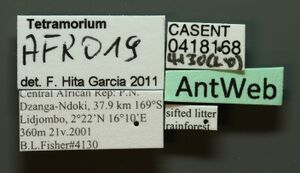Tetramorium pylacum
| Tetramorium pylacum | |
|---|---|

| |
| Scientific classification | |
| Kingdom: | Animalia |
| Phylum: | Arthropoda |
| Class: | Insecta |
| Order: | Hymenoptera |
| Family: | Formicidae |
| Subfamily: | Myrmicinae |
| Tribe: | Crematogastrini |
| Genus: | Tetramorium |
| Species: | T. pylacum |
| Binomial name | |
| Tetramorium pylacum Bolton, 1980 | |
A rainforest species that has primarily been found via leaf litter sampling. There are also records of a hand collected ground-forager and a pitfall trap sample.
Identification
Bolton (1980) - The two species T. pylacum and Tetramorium saginatum represent a separate complex within the group, closely related to the members of the flabellum-complex and derived from them. Both complexes share the same basic characters within the group but in T. pylacum and T. saginatum the heads are relatively broad (CI 89-95) and the antennal scapes shorter (SI 80-85) than is usual in flabellum and its allies (CI 84-89, SI 90 - > 100). Tetramorium pylacum is quickly separable from its closest relative T. saginatum as in the former the base of the first gastral tergite is sculptured with fine dense costulation with punctulate interspaces, whereas in the latter the base of the first tergite is unsculptured except for the pits from which stout hairs arise.
Keys including this Species
Distribution
Latitudinal Distribution Pattern
Latitudinal Range: 6.417222222° to 6.283333333°.
| North Temperate |
North Subtropical |
Tropical | South Subtropical |
South Temperate |
- Source: AntMaps
Distribution based on Regional Taxon Lists
Afrotropical Region: Cameroun, Central African Republic, Ghana, Ivory Coast (type locality).
Distribution based on AntMaps
Distribution based on AntWeb specimens
Check data from AntWeb
Countries Occupied
| Number of countries occupied by this species based on AntWiki Regional Taxon Lists. In general, fewer countries occupied indicates a narrower range, while more countries indicates a more widespread species. |

|
Estimated Abundance
| Relative abundance based on number of AntMaps records per species (this species within the purple bar). Fewer records (to the left) indicates a less abundant/encountered species while more records (to the right) indicates more abundant/encountered species. |

|
Biology
Castes
Worker
Images from AntWeb
   
| |
| Worker. Specimen code casent0425958. Photographer Shannon Hartman, uploaded by California Academy of Sciences. | Owned by CAS, San Francisco, CA, USA. |
Queen
Images from AntWeb
   
| |
| Queen (alate/dealate). Specimen code casent0418168. Photographer Shannon Hartman, uploaded by California Academy of Sciences. | Owned by CAS, San Francisco, CA, USA. |
Nomenclature
The following information is derived from Barry Bolton's Online Catalogue of the Ants of the World.
- pylacum. Tetramorium pylacum Bolton, 1980: 301, figs. 82, 85 (w.) IVORY COAST.
Unless otherwise noted the text for the remainder of this section is reported from the publication that includes the original description.
Description
Worker
Holotype. TL 3.7, HL 0.90, HW 0.84, CI 93, SL 0.68, SI 81, PW 0.62, AL 1.06. Paratypes (6 measured): TL 3.3-3.7, HL 0.82-0.90, HW 0.74-0.84, CI 91-94, SL 0.62-0.68, SI 81-85, PW 0.55-0.64, AL 0.98-1.08. Maximum diameter of eye 0.14-0.16, about 0.18-0.20 x HW.
Mandibles longitudinally striate. Anterior clypeal margin entire, without trace of a median notch or impression. Median clypeal carina strong, flanked by a pair of weaker carinae between which are a pair of still weaker rugulae. Frontal carinae strong, running back almost to occipital margin. Antennal scrobes broad and shallow. Maximum diameter of eye 0.16, about 0.19 x HW. Alitrunk relatively short and broad (see measurements), the dorsum in profile convex. Propodeal spines long and strong, very feebly sinuate along their length. Metapleural lobes broadly triangular and acute. Petiole in profile roughly rectangular, the dorsal length of the node greater than the height of the tergal portion; the dorsum itself shallowly convex. Node of petiole in dorsal view slightly longer than broad. Dorsum of head with spaced longitudinal rugae which are almost as strongly developed as the frontal carinae; seven such rugae occur between the frontal carinae at the level of the eyes. Occipitally the rugae with a few anastomoses but without a developed reticulum. Dorsal surfaces of alitrunk, petiole and postpetiole irregularly reticulate-rugose, the meshes on the pedicel segments finer and more closely packed than on the alitrunk, and also more irregular. Base of first gastral tergite finely and quite densely longitudinally costulate, the spaces between the costulae finely punctulate. All dorsal surfaces of head and body with numerous stout, standing hairs, most of which are blunt apically. Dorsal (outer) surfaces of hind tibiae only with minute decumbent pubescence. Blackish brown, the first gastral tergite slightly lighter brown.
Paratypes: As holotype but some with only three carinae on the clypeus, the median rugulae missing or vestigial. Seven or eight rugae may be present between the frontal carinae at eye-level and rarely a weak reticulated strip is present on the extreme posterior portion of the occiput.
Type Material
Holotype worker, Ivory Coast: Tai Forest, 11.iii.1976, no. 7 (T. Diomande) (The Natural History Museum). Paratypes. Ivory Coast: 4 workers with same data as holotype; 2 workers, Nzi Noua C.I., 17.iii.1969 (J. Lévieux) (BMNH; Museum of Comparative Zoology).
References
References based on Global Ant Biodiversity Informatics
- Bolton B. 1980. The ant tribe Tetramoriini (Hymenoptera: Formicidae). The genus Tetramorium Mayr in the Ethiopian zoogeographical region. Bulletin of the British Museum (Natural History). Entomology 40: 193-384.

